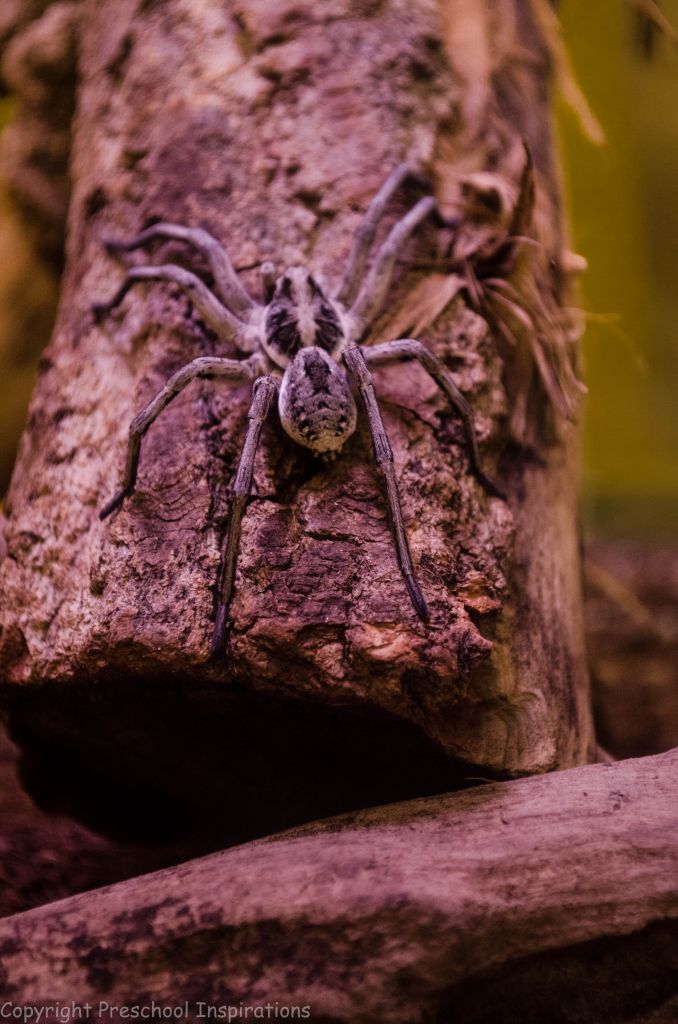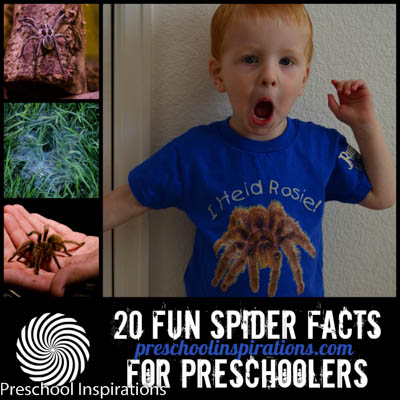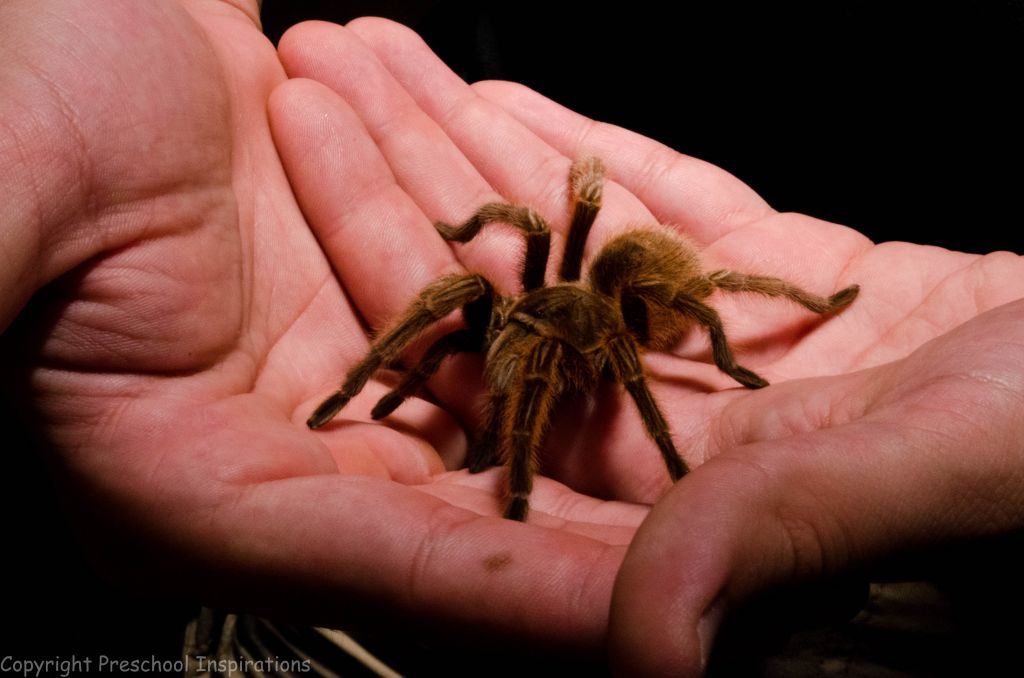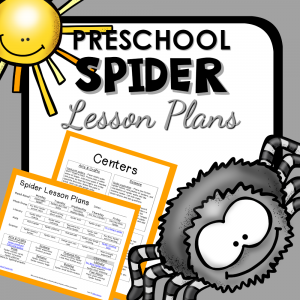Spiders are a great topic to learn about for kids, especially since they are all around us. I’ve put together 20 fun spider facts for preschoolers and kids.
Many of the photographs of the spiders in this post were taken at The Butterfly Pavilion in Denver, CO. And yes, my little guy did hold a tarantula. I did too, and it was a super fun experience! Who knew that I could ever work past my own fear of spiders?
Spider Facts for Kids
20 Fun Spider Facts for Preschoolers:
1) Spiders are not insects. Instead, spiders are known as arachnids because they only have two body segments instead of three. Other arachnids are scorpions, mites, and ticks.
2) Spiders spin webs to catch other bugs to eat, but not all spiders make webs! Some actively hunt their prey and pounce.
3) Most spiders are not dangerous to humans.
4) The wolf spider carries her babies on her back with her.

5) Most spiders live on land, but a few, like the raft spiders, live in and on water. These spiders can “run” across the water’s surface.
6) On average, it takes a spider about 60 minutes to spin a web.
7) Spiders are just as valuable to the world as larger animals, but most people don’t realize it. Many spiders are becoming endangered and are disappearing due to loss of habitat (home).
8) The average house has 30 spiders.
9) You are always three feet away from a spider.
10) Grass spiders build a web on top of the grass. Their webs form a funnel shape, which is not sticky.
11) The silk strands in a web are 5x stronger than a piece of steel the same size.
12) Spiders have short hairs on their feet that allow them to walk upside down on ceilings and over glass.
13) Spiders are found everywhere in the world except for the cold polar regions of the Arctic and Antarctic.
14) The average life of a spider is one to two years. Although the female tarantula may live up to 20 years!
15) The silk is a liquid inside the spider’s abdomen. When the spider releases it, it becomes solid and forms a thread.
16) Some spiders eat their old web before starting a new one. Others roll the old web up and throw it away. Web spiders rebuild their web each day!
17) Spiders don’t usually eat their prey because they have small mouths. Instead, they put chemicals into and on the prey to turn the body into a liquid. Then the spider sucks it up.
18) The hair on a spider’s first pair of legs are sensitive to taste. The spider “tastes” its prey by touching it.
19) Spiders use muscles to move their legs inward toward their body. But they don’t have muscles to pull their legs out. So to move legs out, a spider has to pump body water into each leg. This is why you can sometimes see a spider curled up – he has lost too much water to push his legs out again.
20) Some spiders, such as the tarantula, are considered a low-maintenance pet.
Many of these spider fun facts are taken from:
(1) Bugs and Insects – Sticker Activity Book by Sally Morgan. 2008.
(2) Bugs by Penelope York. 2002.
- Rainbow Sensory Bottle - March 3, 2024
- Teaching Neurodivergent Children in Early Childhood Education - January 8, 2024
- Creating Musical Memories: Teaching Music in Preschool - October 6, 2023




Thank you for helping me learn more about spiders!
Thanks for visiting Deirdre! I even learned a ton while compiling this. Spiders are definitely fascinating! I appreciate you stopping by!!
Can’t wait to share some of these fact with the kids today!
Stopping in from Share It Saturday hop ~
I just love to watch kid’s faces when they hear some of these facts. Thank you so much for stopping by, and I appreciate the comment!
I have to admit that spiders are not my favourite creature, but I have a little boy who likes them and these are great facts to teach him! (Although, the one about there being 30 spiders in the house and always being only 3 feet away from a spider are making me feel a little creepy…) 🙂
I found your post on Share It Saturday. Thank you for sharing!
It’s pretty amazing what our kids can get us involved in, isn’t it! I’ve always had a lot of respect for them but kept my distance. Now I know I was only kidding myself. Thanks for visiting Missy Priebe!
That’s true! The things we do for our kids 🙂
And it’s so worth it!! How exciting for your little one that you are delving into spiders for him!!
Number nine is actually incorrect.
The “never more than three feet away” thing seems to have originated in 1995 when arachnologist Norman Platnick began an article with “Wherever you sit as you read these lines, a spider is probably no more than a few yards away.” Which is technically true, especially if you keep in mind the “probably” modifier. But, as the years went by, the line was repeatedly misquoted by other articles, evolving into “Scientists estimate you’re never more than three feet from a spider.” Even Platnick misquoted himself in a CNN interview, saying that “You’re probably within seven or eight feet of a spider, no matter where you are.”
If you’re standing in a lush grass lawn, then yeah, there might be tiny, harmless spiders right under your feet or as close as a few centimeters. If you’re in parking lot, on the other hand, the closest spider could be as far as 100 feet. If you’re in a jet over the ocean, the closest spider might be a ballooner getting sucked into the engines. So you probably do pass by a lot of spiders without ever even knowing it, but there’s no scientific claim or study that ever said you were always within a certain distance of one.
This is copied from the website “cracked” and the same thing is repeated on many myth-breaking websites..
Thank you for the detailed explanation, Dakota! Now people can rest at ease knowing it’s just a generalization and there aren’t always spiders lurking absolutely everywhere :).
Wow! This is a very useful sight. Thanks a lot for giving these info handy. This helped me.
I’m so glad to hear that! It’s a pleasure having you visit :).